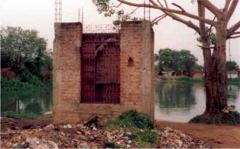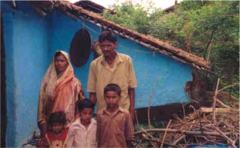Bilaspur, August 2002. At one corner of the big pond in Chingrajpara stands a half-built structure, surrounded on all sides by ever-growing heaps of garbage. It is hard to guess that this recent ruin was begun in fact as a shrine, one of the many that dot the slum. When the fluctuating fortunes of the unknown builders forced its abandonment, it went from temple to trash.

![]() Temple amid trash. Pic: Ashima Sood.
Temple amid trash. Pic: Ashima Sood.
To build a temple in Chingrajpara is almost a declaration of having arrived. Almost. For as the sad structure by the pond testifies, there are as many snakes as ladders on the path of upward mobility in the slum.
I. Education: ladder or snake?
Vimal Devangan looks away, smiling wryly as his wife Mahindri counts the number of times he has tried to hang himself by the ceiling hook in the inner room. He is the shy one in this family; Mahindri is the one who does the talking - in Chhattisgarhi. A small unlettered woman who looks younger than her thirty odd years, this is not a role that comes easily to her; she glances repeatedly, anxiously at her much better educated husband for his approval during the course of her account. Meanwhile three of their youngest children - two boys, eight and five, and a girl of four all mill around, having taken off from school.
Vimals story had a promising beginning. Only son of a weaver caste family that moved from one of the surrounding villages to the city when he was still young, Vimal completed his class eleven in Lal Bahadur Shastri Higher Secondary, Bilaspurs leading government high school. For a family of first generation literates and limited means, this was an advance in itself the idea of college lay just beyond the horizon of possibilities. Like many of his generation Vimal emerged with a set of expectations about the kind of livelihood that his years in school entitled him to expectations that in ensuing years went unmet. In the meantime Vimals own family continued to grow. Vimals most recent disappointment was a small-scale mechanic shop he set up on a cart with funds borrowed from his fathers dwindling savings the shop that got smashed by a belligerent uncle during a family quarrel.
Many other parents in Chingrajpara drawing lessons from cases like Vimals conclude that formal education does not work. There are few high school graduates in Chingrajpara and fewer college graduates; from the meager evidence that is available to Chingrajpara parents, degrees do not correlate with economic success in the slums milieu. Roopchand Gandharv (Slum Diaries VII) is not the only such parent. He and his wife Rukmini, both unlettered, took their eldest son Deepak out of school after class seventh and sent him to apprentice at a motor mechanic shop in nearby Raj Kishore Nagar. Now seventeen year old Deepak brings home nearly a third of the familys total earnings and helps pay off the family debt. He earns his pocket money by delivering milk bottles and dreams in the future of saving enough to open his own motor mechanic shop.
Vimal and Mahindris fifteen year old eldest son still attends class nine in the local high school.
II. Costs of youth
The dependency ratio ratio of dependents to non-dependents - is as succinct a predictor of prosperity within the family as it is for nations. Read this way, families with young children and single breadwinner (like the Devangans) are inevitably positioned in financially precarious territory. Like the Devangans too, many families bargain on the womans labour to rescue them from difficult times. Indeed even as expenses on life cycle events such as weddings grow when the children do, the extra sources of income can enable the family to climb up few rungs on the economic ladder.
As can the pooling of resources in the joint family. Family units with breadwinners in more than one generation often manage to wrest a degree of economic comfort simply on the strength of numbers. Atmanand Gandharvs extended clan is an excellent example. Atmanand arrived from his village in Bilaspur district in the early 1980s, driven by the drought that also brought many other migrants to Chingrajpara. After a lifetime of rickshaw-driving, Atmanand now has the aid of four grown-up sons, two of them married, to add to the family resource pool. The familys house with its four rooms and spacious yard is larger than most and while Atmanand and his eldest son continue to drive hired rickshaws, the family has managed now to start a kabadi shop in the Sanichari, managed by two of the younger sons.
While the family is a reliable guarantor against financial disaster, it is also a resource often not available to recent migrants and the youngest families.
III. Saving miracles
Chingrajpara is a place of miracles. On a daily basis its workers transform the narrow or non-existent economic surpluses their precarious livelihoods afford them into concrete savings.
Kiran Sahu (Slum Diaries I) for instance estimates that she manages to save Rs 300 every month on her hamaals earnings, with five children to feed and an alcoholic husband. And over the last four-five years, she has lost no less than Rs 15000 in various banks and cooperatives, including a so-called Memorial Bank and a fly-by-night cooperative.

![]() A Chingrajpara family: Moving up or down? Pic: Ashima Sood.
A Chingrajpara family: Moving up or down? Pic: Ashima Sood.
And tales of such losses can be heard from other Chingrajpara residents, often female and often illiterate. Kamala Lodhi (Slum Diaries II) lost about Rs 12000 to an Atma Bank; even Nandkumar Devangan (Slum Diaries II) who has since made a success story of thrift lost a sum to a bank named Nagrik/Citizen. While some of these small-time banks such as the Memorial appear to have survived for a few years before their inevitable insolvency, others seem to be straightforward fraud operations, out to take advantage.
There are ways to save available to Chingrajparas resident other than hoarding but to the poorest and the unlettered they are either inaccessible or riddled with the same issues of reliability. There are the BCs, short for Bachat (Savings) Committees (similar to the bhishis in Vidarbha - see P. Sainaths Of chit funds and loan lotteries) but their minimum contribution levels are often outside the reach of the poorest. Mehnat Lal for instance runs many BCs in the locality but the lowest one starts at Rs 200 per week or roughly Rs 800-900 per month. The Maharajin of the Mahila Samiti (Slum Diaries II) also runs BCs starting at weekly contributions of Rs 50 i.e., Rs 200-225 monthly; while this is not a prohibitive sum, earnings fluctuations can make it hard to sustain. Even so the Maharajin has a few hamaal families participate in her BCs. Families like Vimal and Mahindri Devangan have had to borrow from their BC and had difficulty paying back.
Nemichand, the local agent for a Sahara India Fixed Deposit scheme claims about 36 customers in Chingrajpara in the four months he has been operating here, predominantly skilled labourers and vendors. Interestingly Nandkumar Devangan credits just such a scheme for the saving that allowed him to set up his grocery shop. While the agency is still young, many of the families I speak to are led to skepticism by their past experiences.
The self-help groups (SHG) of the Asha Abhiyan initiated Mahila Samitis remain the most trusted avenue; yet at contribution levels of Rs 20 monthly, they fail to tap the substantially larger savings capacity of even the least well off of families. Thus there are options for saving relatively high and stable amounts in the BCs and fixed deposit schemes or saving nominal amounts with semi-state sponsored schemes like the Mahila Samiti SHG. The middle ground remains vacant. What the workers and savers of Chingrajpara need is not so different then from what the workers and savers of Dalal Street demand - savings instruments that offer judicious combinations of both flexibility and reliability. Even as micro-credit schemes continue to gain ground, the surpluses of Chingrajparas poor promise revolutionary, even miraculous fruit.
IV. Start Point, End Point
Not all of the variables that factor into economic success in Chingrajpara can yield outcomes as rapidly. Even though traditional barriers of caste are far less visible in the slum than in the village, they continue to determine the point at which each migrant starts out. In Chingrajpara, as in the rest of India, these dramas play out in predictable and unpredictable ways. Brahmin children are better dressed than all others; Chingrajparas biggest house, a towering two-storey structure (always on the lookout to pump in more than its fair share of the piped water to the annoyance of the managing Mahila Samiti) belongs to Thakurs. Backward castes such as Devangans and Sahus are on a communal path of upward mobility, partly fueled by initial resource sets. Even the local tailor, Nekchand whose shop fronts the main Seepat Road has had his elder son gain admission to an engineering college in Raipur on SC status.
How far one goes in Chingrajpara is a function of where one starts this is the self-evident fact. Yet for the many migrants that continue to throng the slum, arrival is the first rung on the ladder of upward mobility. The upward momentum in the slum as in the village is created by ones own drive and determination it is only the lucky few who are successful enough to break into the middle classes and become eligible for government largesse. It is not surprising then that community development projects such as Asha Abhiyan find themselves faced with a peculiar dilemma in the synthetic community that is Chingrajpara, the path of success leads outside and beyond the slum. Each one is for himself in community projects; and each one is seeking escape from the physical and resource limitations of the slum. Finding committed leadership in this paradigm becomes a challenge.
Chingrajpara and other slums continue thus to be the no-mans lands of policy interventions. And outside the vast apparatuses of public policy, the people of Chingrajpara continue to negotiate difficult circumstances with good humour and cheer. Performing daily feats of amazing grace.
